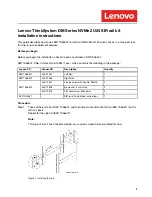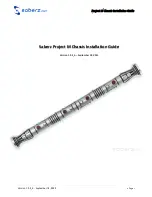
Pin and socket connectors
29
Model 6476 User Guide
3 • System Architecture
Pin and socket connectors
The connection between boards and backplane is through a two-piece, 2 mm connector. Backplanes use male
(pin) connectors and plug-in boards use female (socket) connectors. This pin and socket connector offers
greater reliability, particularly when subject to shock, vibration, or temperature variations.
These pin and socket connectors provide:
•
Faster propagation times
•
Reduced reflection at the bus/connector interface
•
Lower noise
•
Better impedance matching
•
Higher mechanical stability
The connector is a 235-pin device, arranged in 47 rows of 5 pins, with a total of 220 pins (15 pins are lost to
the keying area). The connector is shielded and devotes a large number of pins to ground. This reduces reflec-
tions, increases EMI immunity in noisy environments, and reduces ground bounce.
The fixed or male connector on the backplane is numbered P1-P5, starting at the bottom. The corresponding
female connectors on the 6U cards are numbered J1–J5 from the bottom up (see
figure 11
).
Figure 11. J1 through J5 connectors on the 6U card
3U and 6U cards use a single 220 pin connector for all power, ground, and all 32- and 64-bit PCI signals. This
connector consists of two halves—the lower half (110 pins) is called J1/P1 and the upper half (also 110 pins) is
called J2/P2. Twenty pins are reserved for future use. The connector is divided in J1/P1, a 25-row connector
that includes voltage keying, and J2/P2, a 22-row connector without keying. The 4U card can have up to four
additional connectors with a total of 315 pins, which can be used for a variety of purposes.
J1
J2
J3
J4
J5
Key Area
Key Area
110 Pins
110 Pins
110 Pins
110 Pins
95 Pins
PICMG Defined I/O
or User Defined I/O
Optional sub-bus
e.g., CT H.110 Bus
64-bit PCI Local Bus
and System Slot Cntr.
or PICMG Defined I/O
or User Defined I/O
6U Card
32-bit PCI Local Bus












































